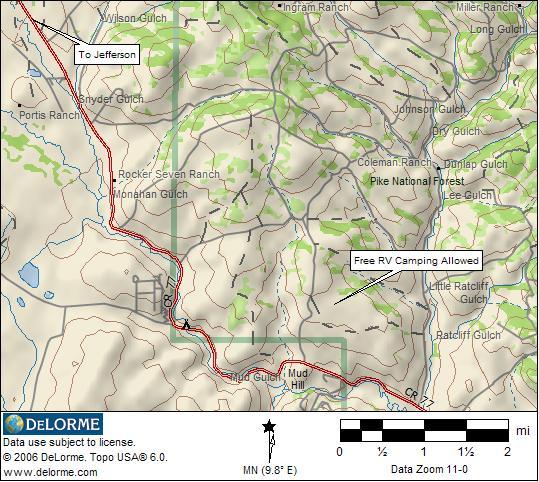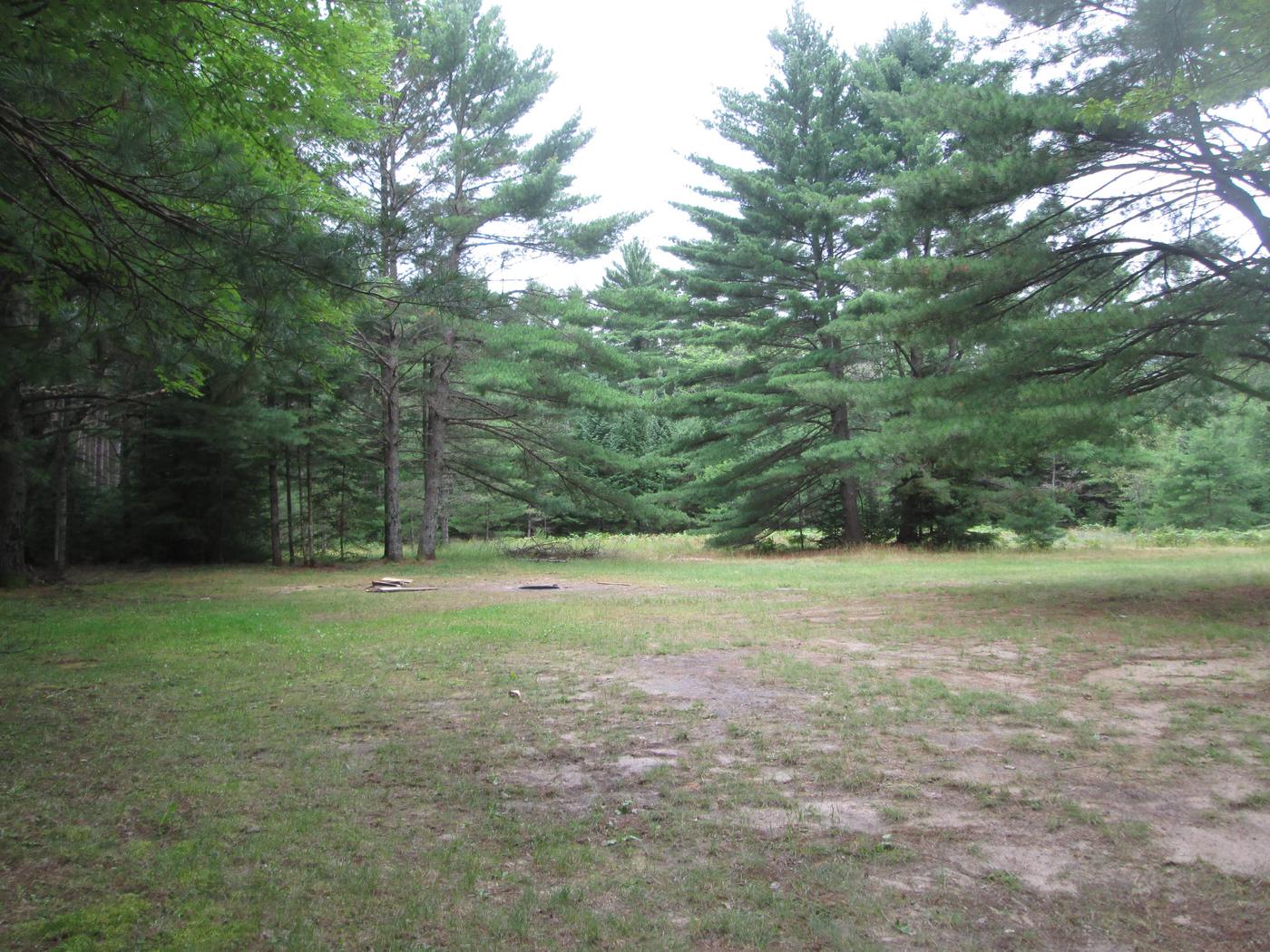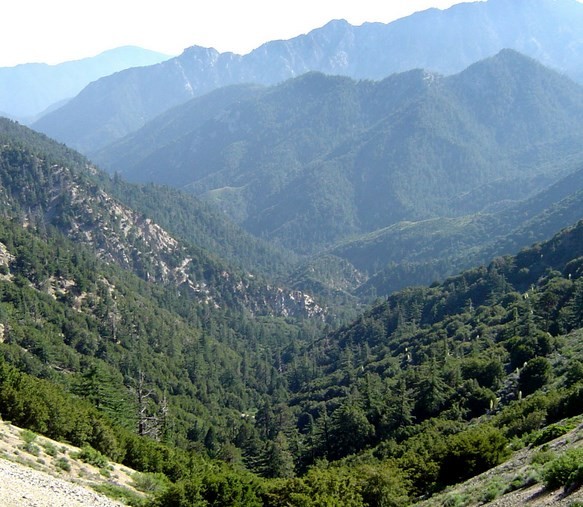The Dixie National Forest allows open dispersed camping outside of developed recreation areas and other areas with specific closures. Dispersed car camping can be done up to 150 feet away from a forest road. The stay limit in the Dixie National Forest is 16 days in one location, after which you must move at least 10 miles away. Some specific popular dispersed camping areas allow camping in only designated dispersed campsites. For complete information on dispersed camping in the Dixie National Forest, click here.
The Arapaho National Forest offers dispersed camping in most of the forest's land. Their rules are pretty standard on following leave no trace principles and not trespassing on private land. They limit dispersed camping to 14 days before you must move at least 3 miles, in addition, there is a 28 day stay limit in a 60 day period.
Dispersed camping is prohibited in their developed areas such as trailheads and picnic areas. For full details on dispersed camping in Arapaho National Forest, click here. The Fishlake National Forest offers dispersed camping in many areas of the forest outside of developed recreational areas. You must disperse camp at least one mile away from developed campgrounds and 100 feet from any water source. The stay limit in the Fishlake National Forest is 16 days in one location, after which you must move at least 5 miles away and may not return to the same camping location within the same calendar year.
For complete information on dispersed camping in the Fishlake National Forest, click here. The San Juan National Forest offers dispersed camping in both designated areas and in undesignated areas. They do note that some areas are closed to dispersed camping including some seasonal restrictions that may be in effect.
They prefer that you contact the local ranger district office before heading out on a dispersed camping trip in the San Juan National Forest. In addition, there is a 28 day stay limit in any 60 day period in the entire forest with a 14 day stay limit in any one location. For full information on dispersed camping in the San Juan National Forest, click here. The Routt National Forest offers dispersed camping in most areas of the forest. They do not expressly list dispersed camping rules and regulations on their websites, instead, they ask that you contact the ranger district where you plan on going camping.
Most likely the rules are pretty standard with things such as leave no trace, stay limits and camping outside of developed areas. For more information on dispersed camping and contact information for the Routt National Forest, click here. The Olympic National Forest offers many opportunities for dispersed camping provided you follow some basic rules. You must disperse camp at least a quarter mile from any developed recreation site. The stay limit in the Olympic National Forest is 14 days in any 30 day period.
For complete details and information on dispersed camping in the Olympic National Forest, click here. The Gila National Forest allows dispersed camping anywhere on the forest outside of developed areas for no charge. There are also many designated primitive campsites in the Gila National Forest. Detailed maps with regulations on where vehicles may go can be picked up from one of the six ranger stations within the forest. You do not need a permit to disperse camp in the Gila National Forest, but there is a 14 day stay limit in a 30 day period.
For complete information on dispersed camping in the Gila National Forest, click here. The Bighorn National Forest offers dispersed camping in many areas within the forest. You may disperse car camp up to 300 feet away from a forest road as long as it is not posted or damaging the land.
The stay limit in Bighorn National Forest is 14 days in any 28 day period. For complete information and a list of specific closures in Bighorn National Forest, click here. The Apalachicola National Forest allows dispersed camping in may of the forest's land. During the general gun season camping is only allowed in designated campsites. There is also a 14 day stay limit per month in Apalachicola National Forest. Other rules and regulations provided are basic leave no trace principles.
For complete information on dispersed camping in the Apalachicola National Forest, click here. The Sierra National Forest allows plenty of dispersed camping and outlines its rules and regulations clearly. Like most other forests, they do not allow dispersed camping within the vicinity of developed recreation sites. You must set up camp at least one mile away from developed campgrounds and at least 100 feet from water sources.
For full details on dispersed camping in the Sierra National Forest, click here. The Gifford Pinchot National Forest offers dispersed camping in many areas of the forest away from developed areas. You must camp at least 100 feet away from major roads and trails as well as water sources. The stay limit in the Gifford Pinchot National Forest is 14 days in one location, after which you must move at least 5 miles away. For more information on dispersed camping in the Gifford Pinchot National Forest, see their dispersed camping page with a nice .pdf document here.
The Black Hills National Forest allows dispersed camping in most areas of the forest away from developed areas. The stay limit in the Black Hills National Forest is 14 days in any 60 day period. It is recommended that you contact the Black Hills National Forest Service office prior to your trip for the most up to date information on dispersed camping.
For contact information and complete dispersed camping rules and regulations in the Black Hills National Forest, click here. The Shawnee National Forest permits dispersed camping within the forest except for developed recreation areas, natural areas, on lakeshores, near streams, or on designated trails. Dispersed camping is free and available at any time of the year.
However, if you are horse camping then the Shawnee National Forest does not allow you to camp in designated wilderness areas. The dispersed camping stay limit in the Shawnee National Forest is 14 days. For complete information on dispersed camping in the Shawnee National Forest, click here. The Caribou-Targhee National Forest has three ranger districts that all allow dispersed camping in many of the areas of the forest. Each ranger district has its own special rules and regulation so it is advised that you contact the specific ranger district before heading out on your dispersed camping trip. For example, in the Palisades Ranger District, they say that camping is free and available in many undeveloped sites, but there is a 16-day stay limit in one spot.
Additionally, select areas have a camping stay limit of only 5 days. The Stanislaus National Forest provides a nice document containing its rules on dispersed camping. They impose a 21 day stay limit per year per ranger district.
They also list 4 very specific areas where dispersed camping is not allowed, so you should check out their document before going camping in the Stanislaus National Forest. Other information they provide is pretty standard leave no trace principles. You also must camp at least 200 feet away from springs, water, meadows, trails, and roads. Additionally, they want you a quarter mile away from developed areas like campgrounds, trailheads, and picnic areas. Of course, you are also expected to follow leave no trace principles. Wilderness areas generally will require a free permit in the forest.
For complete information on dispersed camping in the San Bernardino National Forest, click here. In addition to Millard Falls and Dawn Mine, the campground offers access to trails to Inspiration Point and San Gabriel Peak. Take a couple days off and get out of LA – without leaving the city. Enough trails leave from the campground to keep you busy on a short camping trip. For a nearby trail camp that actually requires you to walk in a couple miles, check out Gould Mesa Trail Camp. The Colville National Forest allows dispersed camping in a majority of the forest outside of developed areas.
The stay limit in the Colville National Forest is 14 days in one spot, after which you must move at least 5 road miles away. For complete information on dispersed camping in the Colville National Forest, click here. The Uinta-Wasatch-Cache National Forest allows dispersed camping in many general areas of the forest outside of its developed recreation areas. The stay limit in the Uinta-Wasatch-Cache National Forest is 14 days in any 30 day period.
A motor vehicle use map is provided by any ranger station so that finding a dispersed camping area is easy. For complete details on dispersed camping in the Uinta-Wasatch-Cache National Forest, click here. The Boise National Forest notes that dispersed camping is available in a majority of its land. Most of the rules provided by the Boise National Forest is basic leave no trace principles that everyone should follow when camping anywhere. For complete details on camping in the Boise National Forest, click here.
The Kaibab National Forest has three ranger districts, and all three allow dispersed camping. Free dispersed camping is allowed pretty much anywhere in the forest 1 mile away from developed recreation sites and for up to 14 days within any 30 day period. For more information on dispersed camping in the Kaibab National Forest, visit their dispersed camping page here.
If you plan to build a campfire or use a barbeque or camp stove in a dispersed camping area, you must obtain acampfire permit from a Forest Service, BLM, or CalFire office. Clear an area at least 5 feet wide all the way around your fire ring down to mineral soil. During times of high fire danger, campfires are prohibited; always check with the local fire office or ranger station for fire restrictions. BLM land is best known for its liberal free camping policy–anywhere along existing roads and outside of paid campsites, picnic areas, and trailheads are generally fair game for setting up camp. Much like the liberal dispersed camping policies in National Forests, you can hike in a bit, make use of a pullout, or enjoy a secluded spot along an access road.
However, be prepared to give up the typical amenities–table, toilets, bear lockers, and yes, water–for your peaceful getaway. While not every campsite or overnight stay on BLM land is free, the fee for a permit or a built-out spot will still only set you back a green juice or two. This is one campsite that it pays to be prepared; book far ahead because the sites can book up months in advance. The group camp is popular with kayakers because of beach access.
From start to finish, it's a great trip, featuring a private campsite, often with spectacular views of San Francisco Bay, the San Francisco waterfront and skyline, Marin Headlands, and Mount Tamalpais. The tromp up to 798-foot Mount Livermore includes a short, steep stretch, but in return furnishes one of the most spectacular urban lookouts in America. The park features more than 13 miles of trails, including Perimeter Road, a must-do for all avid cyclists. Angel Island has a stunning history, including being used from 1910 to 1940 to process thousands of immigrants as they entered America; historic tram tours are available. The Rogue River-Siskiyou National Forest offers dispersed camping in five main ranger districts within the forest.
The ranger districts are Gold Beach, High Cascades, Powers, Siskiyou Mountains, and Wild Rivers ranger districts. The Custer Gallatin National Forest allows dispersed camping in most general forest areas. They provide a motor vehicle use map that shows what locations you may disperse car camp. You may not disperse camp in the vicinity of developed recreation areas.
The stay limit in Custer Gallatin National Forest is 16 days, after that, you must move at least 5 miles away and may not return to the original campsite until at least 7 days have passed. For more information on dispersed camping in the Custer Gallatin National Forest, click here. The Sawtooth National Forest offers plenty of dispersed camping outside of developed campgrounds. The Sawtooth National Forest also provides a really nice document with their dispersed camping rules and regulations. The Sawtooth National Forest has imposed some special stay limits in certain dispersed camping areas.
For example, north and south of Galena Summit there is a 16-day stay limit. In the Salmon River Corridor, there is a 10-day camping limit. They also provide contact information in their document for any other concerns or questions one might have regarding dispersed camping within the Sawtooth National Forest.
The Clearwater National Forest has opened most of the forest to dispersed camping. The Clearwater National Forest has a stay limit of 18 days in one dispersed camping location. In order to reset the clock on this 18 day stay limit, one must move at least 5 miles away from the original campsite. Additionally, you may not return to the same campsite for at least 45 days. Some popular dispersed camping areas may have additional rules posted.
For complete information on dispersed camping in the Clearwater National Forest, click here. The Chattahoochee-Oconee National Forest offers dispersed camping in multiple locations throughout the forest. It is allowed in both general forest areas and designated wilderness areas provided you follow basic leave no trace principles. For complete information on dispersed camping in the Chattahoochee-Oconee National Forest, click here. The Roosevelt National Forest offers dispersed camping on most of the forest. The Roosevelt National Forest follows the same rules as the Arapaho National Forest.
They limit dispersed camping to 14 days in any one location and a 28 day limit total in any 60 day period. Like most other forests, you may not disperse camp in developed areas such as trailheads and picnic areas. For full information on dispersed camping in the Roosevelt National Forest, click here.
The Mendocino National Forest follows the basic same dispersed camping rules as most forests do. You may openly disperse camp pretty much anywhere that is not expressly posted as prohibited. Dispersed camping in one spot in the forest is limited to 14 days at a time.






















